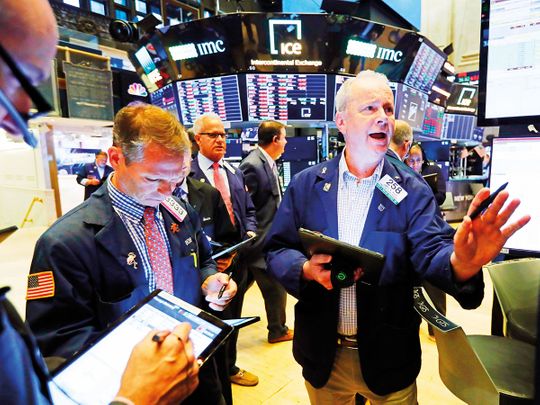
New York
Forgive stock investors for feeling whipsawed. They just endured one of the wildest weeks of the bull market only to see the S&P 500 end not far from where it started.
The rapidly escalating trade war bears the blame, sure, but that’s not going away anytime soon. What matters for financial markets is the impact on future growth, and equity traders looking for guidance often turn to Treasuries. The problem there is that bulls and bears can both find succour.
Stock sceptics look at yields that tumbled toward three-year lows and see a warning that the economy is doomed, no matter the trade war’s outcome. For bulls, the same bargain-bin rates make equities especially attractive when compared with earnings using what’s known as the Fed model.
“It’s more than just a concern about tariffs, it’s a concern about a global slowdown. Then the question becomes, would a significant rate cut by the Fed staunch it?” said Quincy Krosby, chief market strategist at Prudential Financial Inc. “What you want is investors taking advantage of lower stock prices. But if you keep thinking, ‘it’s going to get lower,’ you’ll keep your cash.”
The S&P 500 slipped 0.5 per cent over the five days, suffering the year’s worst rout Monday and another modest drop Friday. Sandwiched in between was the biggest three-day rally in two months. Trade headlines caused the ructions, and quant traders and balanced funds accounted for some of the intraweek gyrations, but in the end, investors were left to handicap whether the economy can withstand a level of global policy uncertainty that’s near a record.
“It has been treacherous to even dip your toe into the water,” said Peter Tchir, head of macro strategy at Academy Securities. “This pattern of large, rapid moves, sometimes in reaction to headlines, and even more befuddling, sometimes occurring with no obvious headline in sight has created an environment where it is extremely difficult to trade or manage risk.”
After Monday’s rout, equity bulls went off to the weekend pleased the S&P 500 sits just 3.5 per cent below an all-time high reached 10 sessions ago. Much of their optimism is based on relative valuations. Among 22 Wall Street strategists tracked by Bloomberg, more than half have cut their profit forecasts for the S&P 500 since the start of May, but none lowered their year-end price targets. Lower rates make stocks look more attractive, they say.
Indeed, with a record $15 trillion of global bonds yielding less than zero, the S&P 500 can hardly be framed as expensive when companies hand out dividends equivalent to 1.9 per cent of their share prices. For the first time since 2016, the equity benchmark’s payout exceeded the 10-year Treasury yield.
Of course, not everyone invests in stocks for dividends. And profit growth, a more relevant gauge on business prospects, has slowed to a trickle this year. Even by that measure, stocks remain a bargain. The spread between the S&P 500’s earnings yield — a loose proxy for how much equities “pay” shareholders — and 10-year yields now sits at 3.51 percentage points. That’s higher than 79 per cent of the time over the last two decades.
The “S&P 500 is set up for a monster second-half rally,” said Tom Lee, co-founder of Fundstrat Global Advisors LLC whose year-end forecast for the S&P 500 is the second-highest among strategists. Stable earnings and a dovish Fed “are major supports for the US equity market,” he said.
While hedge funds turned more bearish on stocks amid the latest rout, companies themselves saw bargains. As the S&P 500 tumbled Monday, Goldman Sachs Group Inc.’s unit that executes repurchases for clients saw buy-backs rise “dramatically,” according to David Kostin, the firm’s chief US equity strategist.
To bears, basing stock decisions on their relative valuation to bonds is dangerous as that fails to take into account many things, like the stage of an economic cycle. Even Ed Yardeni, the economist who coined the term Fed model based on a July 1997 report by the central bank, acknowledges its limitation given the institution’s involvement in setting interest rates nowadays.
If you look at history since 2000, the bond comparison has a spotty record. Stocks appeared to be relatively cheap going back that far, yet equities also suffered one of the worst bear markets in history from 2007 to 2009.
“Simply cutting rates is only going to push rates lower and currencies cheaper, and people are going to think we’re in a recession,” said Paul Christopher, head of global market strategy at Wells Fargo Investment Institute. “We have to get ourselves to the point where the bond market isn’t so uncomfortable with the current situation.”












